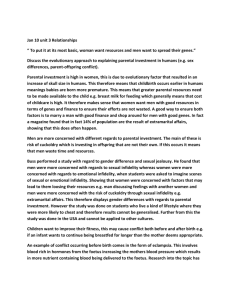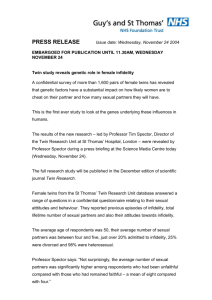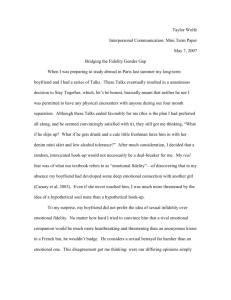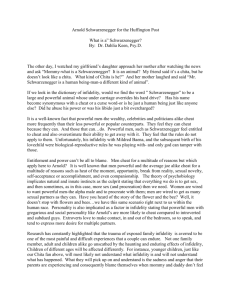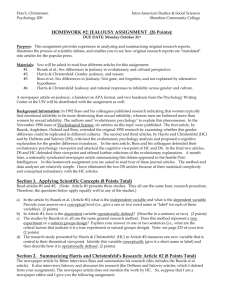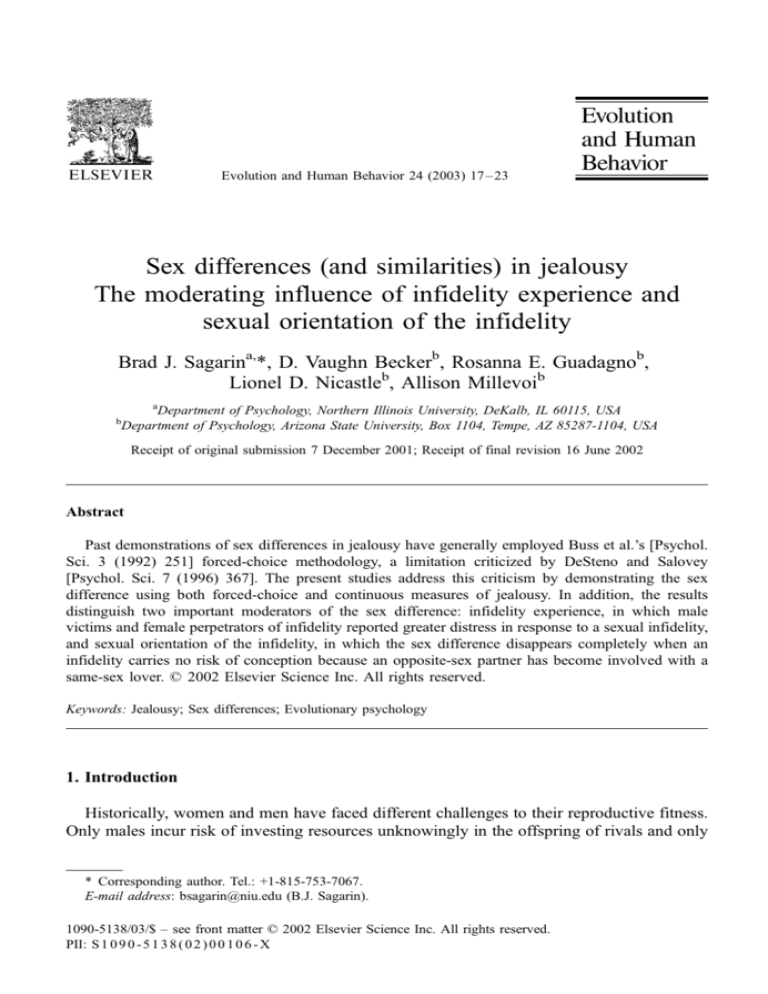
Evolution and Human Behavior 24 (2003) 17 – 23
Sex differences (and similarities) in jealousy
The moderating influence of infidelity experience and
sexual orientation of the infidelity
Brad J. Sagarina,*, D. Vaughn Beckerb, Rosanna E. Guadagnob,
Lionel D. Nicastleb, Allison Millevoib
a
Department of Psychology, Northern Illinois University, DeKalb, IL 60115, USA
Department of Psychology, Arizona State University, Box 1104, Tempe, AZ 85287-1104, USA
b
Receipt of original submission 7 December 2001; Receipt of final revision 16 June 2002
Abstract
Past demonstrations of sex differences in jealousy have generally employed Buss et al.’s [Psychol.
Sci. 3 (1992) 251] forced-choice methodology, a limitation criticized by DeSteno and Salovey
[Psychol. Sci. 7 (1996) 367]. The present studies address this criticism by demonstrating the sex
difference using both forced-choice and continuous measures of jealousy. In addition, the results
distinguish two important moderators of the sex difference: infidelity experience, in which male
victims and female perpetrators of infidelity reported greater distress in response to a sexual infidelity,
and sexual orientation of the infidelity, in which the sex difference disappears completely when an
infidelity carries no risk of conception because an opposite-sex partner has become involved with a
same-sex lover. D 2002 Elsevier Science Inc. All rights reserved.
Keywords: Jealousy; Sex differences; Evolutionary psychology
1. Introduction
Historically, women and men have faced different challenges to their reproductive fitness.
Only males incur risk of investing resources unknowingly in the offspring of rivals and only
* Corresponding author. Tel.: +1-815-753-7067.
E-mail address: bsagarin@niu.edu (B.J. Sagarin).
1090-5138/03/$ – see front matter D 2002 Elsevier Science Inc. All rights reserved.
PII: S 1 0 9 0 - 5 1 3 8 ( 0 2 ) 0 0 1 0 6 - X
18
B.J. Sagarin et al. / Evolution and Human Behavior 24 (2003) 17–23
females are obliged to make substantial post-zygotic investments before a conception can
yield fitness benefits. Thus, ensuring that putative offspring are indeed one’s own is an
adaptive challenge for males, whereas a female faces the different challenge of ensuring that
the father invests resources into her children rather than those of rivals. These considerations
suggest that male and female sexual jealousy will be qualitatively different (Daly, Wilson, &
Weghorst, 1982; Symons, 1979).
Accordingly, Buss, Larsen, Westen, and Semmelroth (1992) predicted that men and
women would differ in their responses to emotional and sexual infidelity, with women being
relatively responsive to the former and men to the latter. Both survey and physiological
evidence supported this hypothesis: when asked which type of infidelity would distress them
more, men were much more likely than women to select the sexual infidelity, and when
subjects were instructed to fantasize about one type of infidelity or the other, measures of
electrodermal activity and heart rate supported the conclusion that the sexes differed in the
two types of infidelity’s relative emotional impacts.
DeSteno and Salovey (1996, p. 371) have argued that these findings have limited
generality, concluding ‘‘Although the sex difference in infidelity choice reported by Buss
et al. (1992) is readily replicable using the forced-choice paradigm, we have been unable to
replicate it using continuous measures asking individuals to rate the amount of distress
experienced in response to each type of infidelity. Failures to find this effect using both
manifest and latent multiple measures of jealousy led us to question the robustness of the
originally reported sex difference outside of the forced-choice paradigm.’’ The present studies
address this criticism by asking participants to indicate their reactions to infidelities using
both forced-choice and continuous measures (see Geary, Rumsey, Bow-Thomas, & Hoard,
1995, for a prior use of a continuous measure of jealousy, and Pietrzak, Laird, Stevens, &
Thompson, 2002, for a recent demonstration of sex differences using continuous measures).
In addition, because sex differences in jealousy are theorized to stem from differential
threats to ancestral male and female reproductive fitness, they may disappear in response to
‘‘infidelities’’ in which reproduction is clearly impossible, namely cases in which an oppositesex partner becomes involved with a same-sex lover. A same-sex infidelity does not entail the
asymmetrical threats of mistaken paternity and of resources being diverted to another
woman’s children, suggesting both that the sexes may be similar in their jealous responses
and that such responses may be less intense than in the case of opposite-sex infidelities.
Is it reasonable to expect evolved emotional responses to infidelity to be modulated in this
way? Two considerations suggest that it may be. First, bisexual behavior is sufficiently well
documented both historically and cross-culturally (Cantarella, 1992; Dynes & Donaldson,
1992a, 1992b) to indicate that responding appropriately to same-sex infidelities is a challenge
with a long history. Secondly, same-sex sexual interactions are sufficiently widespread in
other animals, including other primates (Bagemihl, 1999), to suggest that responding
differentially to the homosexual versus heterosexual behavior of others is an ancient adaptive
problem. Furthermore, since jealousy is a dangerous emotion, with potentially dire ramifications for all concerned (Buss, 1999), it would be reproductively advantageous to feel
intense jealousy specifically when one’s reproductive outcomes are at risk. Thus, we predict
that men and women will differ in their responses to sexual and emotional infidelities with
B.J. Sagarin et al. / Evolution and Human Behavior 24 (2003) 17–23
19
opposite-sex partners, but not with same-sex partners, and that jealousy will be significantly
less intense in the latter case than in the former.
2. Study 1
2.1. Participants
Six hundred and twenty-five undergraduate students completed the questionnaire as part of
a lengthy survey administered in their introductory psychology classes. Because of the
standardized nature of the survey, all questions were answered on a 0–9 scale, even when a
particular question employed a restricted range of valid answers. Of the 625 respondents, 66
were excluded due to out-of-range or missing answers and an additional 46 were excluded
because they answered no to the question, ‘‘Are you currently in, or interested in, a
relationship with a member of the opposite sex?’’ The final sample contained 513
participants: 307 women and 206 men.
2.2. Questionnaire
Participants were randomly assigned to consider either an opposite-sex infidelity (the
forced-choice question of Buss et al., 1992) or a same-sex infidelity:
Please think of a serious committed romantic relationship that you have had in the past, that
you currently have, or that you would like to have. Imagine that you discover that the person
with whom you’ve been seriously involved became interested in someone else [of their same
gender]. What would distress or upset you more:
0: Imagining your partner forming a deep emotional attachment to that person.
1: Imagining your partner enjoying sexual intercourse [sex] with that other person.
All participants then answered two questions that assessed how jealous they would feel
about (a) their partner forming a deep emotional attachment to this other person and (b) their
partner enjoying sexual intercourse [sex] with this other person. These questions were
answered on 10-point scales ranging from not at all jealous (0) to extremely jealous (9).
2.3. Results and discussion
To test for the predicted disappearance of the sex difference when participants considered
same-sex infidelities, we logistically regressed type of infidelity causing more distress on sex
of participant, opposite-sex versus same-sex infidelity, and their interaction. Consistent with
predictions, the interaction was significant, b = .46, S.E.b=.10, Wald (1 df) = 19.96,
P < .001. Participants considering an opposite-sex infidelity displayed a significant sex
difference: 44/86 males (51%) reported greater distress in response to a sexual infidelity
compared to 20/122 females [16%; c2(1) = 28.63, P < .001], whereas those considering a
20
B.J. Sagarin et al. / Evolution and Human Behavior 24 (2003) 17–23
same-sex infidelity did not: 40/120 males (33%) reported greater distress in response to a
sexual infidelity compared to 68/185 females [37%; c2(1) = 0.373, P = .54]. On the continuous measures, both men and women reported significantly less jealousy in response to a
same-sex infidelity as compared to an opposite-sex infidelity, F(1,504) = 40.03, P < .001,
supporting our prediction that both men and women will feel less jealous about an infidelity
that does not carry the risk of conception.
Consistent with the results of the forced-choice question, a significant sex of participant by
type of infidelity interaction emerged for the continuous measure of jealousy, F(1,202) =
11.27, P =.001. For women, emotional infidelity elicited significantly more jealousy (M = 7.49,
S.D. = 1.71) than sexual infidelity (M = 6.92, S.D. = 2.39), F(1,202) = 9.44, P =.002. For men,
sexual infidelity elicited marginally more jealousy (M = 6.72, S.D. = 2.51) than emotional
infidelity (M = 6.39, S.D. = 2.21), F(1,202) = 3.27, P =.07. These results suggest that the sex
difference in jealousy is not an artifact of the forced-choice paradigm. Rather, it appears to be a
robust effect, produced in the present study using both the traditional forced-choice question
and our continuous measures of jealousy.
3. Study 2
Study 2 was designed to replicate the sex difference in jealousy on the continuous
measures and to test a new moderator: infidelity experience. Study 1 revealed that the amount
of jealousy elicited by a particular situation is sensitive to contextual factors like the sex of the
partner’s lover, and if jealousy is attuned to this level of information, we might also expect it
to be attuned to temporal context. Prior experience with infidelity may then sharpen the sex
difference that is already evident. We are postulating that jealousy is an adaptation that has
been selected to make use of ecological variables that correspond to the ‘‘basic level’’ of the
adaptive problem, and that this level must take into account the real possibilities of
conception, and the real probabilities of infidelity.
With respect to infidelity experience, it was predicted that male victims of infidelity will be
particularly sensitive to the possibility of infidelity in the future, leading to greater distress in
response to a sexual infidelity. Indirect support for this prediction can be found in Buss and
Shackelford’s (1997, p. 346) work on mate retention in which they note that ‘‘men’s mate
retention positively covaried with perceived probability of partner’s infidelity.’’ If past
experience as a victim of infidelity increases the perceived probability that the current partner
will stray, these men may increase both their mate retention strategies and their sexual jealousy.
3.1. Participants
Four hundred and twenty undergraduate students completed the questionnaire as part of a
lengthy survey administered in their introductory psychology classes. Four were excluded
due to out-of-range or missing answers and an additional 63 were excluded because they
indicated that they were neither currently in, nor interested in, a relationship with a member of
the opposite-sex. The final sample contained 353 participants: 214 women and 139 men.
B.J. Sagarin et al. / Evolution and Human Behavior 24 (2003) 17–23
21
3.2. Questionnaire
The questionnaire was similar to the one used in Study 1 with the following changes: All
participants considered an opposite-sex infidelity, using the original wording of the forcedchoice question, and all were asked whether a relationship partner had ever cheated on them
and whether they had ever cheated on a relationship partner. Both of these questions were
answered yes or no.
3.3. Results and discussion
Overall, the forced-choice question produced the expected sex difference: 45/214 women
(21%) versus 74/139 men (53%) reported greater distress in response to a sexual infidelity
[c2(1) = 39.12, P < .001].
For men, experience as a victim of infidelity significantly impacted which type of infidelity
caused greater distress: 40/86 men (47%) who had not been cheated on reported greater
distress in response to a sexual infidelity versus 34/53 (64%) who had [c2(1) = 4.10, P =.043].
For women, however, experience as a victim of infidelity had no apparent effect: 20/83
victims (24%) reported greater distress in response to a sexual infidelity, as did 25/131
nonvictims [19%; c2(1) = 0.77, P =.38]. Conversely, experience as a perpetrator of infidelity
significantly impacted these ratios among women [perpetrator: 25/80 or 31%, nonperpetrator:
20/134 or 15%; c2(1) = 8.04, P =.005], but not among men [perpetrator: 23/40 or 58%,
nonperpetrator: 51/98 or 52%; c2(1) = 0.34, P =.56].
As in Study 1, a significant sex of participant by type of infidelity interaction emerged for
the continuous measures of jealousy, F(1,350) = 9.13, P =.003. For women, emotional
infidelity elicited marginally more jealousy (M = 7.59, S.D. = 1.58) than sexual infidelity
(M = 7.32, S.D. = 2.11), F(1,350) = 2.88, P =.091. For men, sexual infidelity elicited significantly more jealousy (M = 7.15, S.D. = 2.47) than emotional infidelity (M = 6.66, S.D. = 2.51),
F(1,350) = 6.31, P =.012. These results replicate the predicted sex difference. Importantly, the
marginal effect for men in Study 1 was significant in Study 2.
4. General discussion
Responding to DeSteno and Salovey’s (1996) claim that sex differences in jealousy are
only manifested using the forced-choice paradigm, the present studies demonstrate them
using both forced-choice and continuous measures, suggesting that the sex difference is a
robust effect and not merely an artifact of the forced-choice paradigm. In addition, the present
studies provide evidence for the moderating influence of infidelity experience and the
complete disappearance of the sex difference when an infidelity involves a same-sex lover.
Study 2 examined infidelity experience as a moderator of which type of infidelity would be
more distressing. It was predicted that for men, experience as the victim of an infidelity would
motivate strong vigilance against similar behavior by future romantic partners, leading to
greater distress in response to sexual infidelity. Results confirmed this prediction. Male
22
B.J. Sagarin et al. / Evolution and Human Behavior 24 (2003) 17–23
victims of infidelity were significantly more likely than male nonvictims to report greater
distress in response to a sexual infidelity. Furthermore, in contrast to the typical 40–50% ratio
for men on the forced-choice question, nearly two-thirds of male victims of infidelity
indicated that a sexual infidelity would cause greater distress.
For women, experience as a victim of infidelity did not serve as a moderator, but
experience as a perpetrator did. Women who reported cheating on a past romantic partner
were significantly more likely to indicate that a sexual infidelity would cause greater distress
compared to women who had not cheated.
Sex differences in jealousy are theorized to stem from the differential reproductive
challenges faced by males and females: male jealousy should function to reduce risks that
female partners will be impregnated by rival males, whereas female jealousy should function
to reduce risks that male partners will divert resources to the children of rival females. These
problems do not apply, however, when reproduction is not a possibility, so where oppositesex partners become involved with same-sex lovers, the sexes need not differ in their jealous
responses. In Study 1, participants considering an opposite-sex infidelity displayed the usual
sex difference, while among those considering a same-sex infidelity, the sex difference
disappeared. Furthermore, as predicted, both men and women reported significantly less
intense jealousy in response to a same-sex infidelity.
From this evidence, we suggest that it is inaccurate to view men and women as manifesting
a gross, context-free sex difference in jealousy. Our results suggest that when men and
women face differential adaptive challenges — when their partners become involved with
members of the opposite sex — they display a large, reliable sex difference, but when
conception is not a possibility — when their partners become involved with members of the
same sex — the differential adaptive challenges disappear, and so do the sex differences.
Acknowledgments
Some of these findings were initially presented at the 2000 meeting of the American
Psychological Association in Washington, DC. We thank Carol Nemeroff and Mary Gerend
for their helpful comments during the development of these studies, Jean Denious for her
review of an earlier draft of this manuscript, and Margie Cook for her help with the
literature review.
References
Bagemihl, B. (1999). Biological exuberance: animal homosexuality and natural diversity. New York: St. Martin’s
Press.
Buss, D. M. (1999). Evolutionary psychology: the new science of the mind. Boston, MA: Allyn and Bacon.
Buss, D. M., Larsen, R. J., Westen, D., & Semmelroth, J. (1992). Sex differences in jealousy: evolution,
physiology, and psychology. Psychological Science, 3, 251 – 255.
Buss, D. M., & Shackelford, T. K. (1997). From vigilance to violence: mate retention tactics in married couples.
Journal of Personality and Social Psychology, 72, 346 – 361.
B.J. Sagarin et al. / Evolution and Human Behavior 24 (2003) 17–23
23
Cantarella, E. (1992). Bisexuality in the ancient world. New Haven: Yale Univ. Press (Cuilleanain, C.O., Trans.,
Original work published 1988).
Daly, M., Wilson, M., & Weghorst, S. J. (1982). Male sexual jealousy. Ethology and Sociobiology, 3, 11 – 27.
DeSteno, D. A., & Salovey, P. (1996). Evolutionary origins of sex differences in jealousy? Questioning the
‘‘fitness’’ of the model. Psychological Science, 7, 367 – 372.
Dynes, W. R., & Donaldson, S. (Eds.) (1992a). Asian homosexuality. New York: Garland Publishing.
Dynes, W. R., & Donaldson, S. (Eds.) (1992b). Homosexuality in the ancient world. New York: Garland
Publishing.
Geary, DC., Rumsey, M., Bow-Thomas, C. C., & Hoard, M. K. (1995). Sexual jealousy as a facultative trait:
evidence from the pattern of sex differences in adults from China and the United States. Ethology and
Sociobiology, 16, 355 – 383.
Pietrzak, R. H., Laird, J. D., Stevens, D. A., & Thompson, N. S. (2002). Sex differences in human jealousy: a
coordinated study of forced-choice, continuous rating-scale, and physiological responses on the same subjects.
Evolution and Human Behavior, 23, 83 – 94.
Symons, D. (1979). The evolution of human sexuality. New York: Oxford Univ. Press.

